Rane PE 17 Handleiding
Rane
Mengpaneel
PE 17
Bekijk gratis de handleiding van Rane PE 17 (4 pagina’s), behorend tot de categorie Mengpaneel. Deze gids werd als nuttig beoordeeld door 10 mensen en kreeg gemiddeld 4.6 sterren uit 5.5 reviews. Heb je een vraag over Rane PE 17 of wil je andere gebruikers van dit product iets vragen? Stel een vraag
Pagina 1/4

Manual-1
PE 17
PARAMETRIC EQUALIZER
OPERATORS MANUAL
QUICK START
Those who choose not to read this modest informational snippet (intended to ward off one of life’s embarrassing
moments) are those who wish to hasten the point at which their entire sound system locks up, screams unmercifully,
shatters windows, causes dogs to howl, babies to cry, and melts all the compression drives, dripping molten titanium all
over the hand-polished walnut decor. Pity.
There are only a few things to check when using a PE 17. Always set both GAIN controls as close to the top of the
panel as possible without causing the OL LED to light constantly. Use the CUT FILTERS to tailor the bandwidth for each
application. Always double check that each FREQx multiplier switch (located beneath each FREQ control) is set to the
correct position. Great surprises result from false settings.
For extra-deep notching applications, use Bands 3 and 4 and set them exactly the same. Notches as deep as 30 dB are
possible, since Bands 3 and 4 are in series while most other bands are in parallel (see the Block Diagram in the Specifica-
tions Section).
Hook-up is simple. The PE 17 accepts all combinations of balanced or unbalanced, XLR or ¼" connectors. However,
the INPUT connectors are wired in parallel and may not be used together. Use only one at a time. They will not function as
a summing type of input for two different sources, but they may be used in a daisy chain fashion to feed other units. On the
other hand (to randomly pick a hackneyed expression), you may use the paralleled Outputs to drive two destinations.
Never connect anything except a Rane approved AC power supply to the thing that looks like a red telephone jack on
the rear of the PE 17.
WEAR PARTS: This product contains no wear parts.

Manual-2
FRONT PANEL DESCRIPTION
OVERLOAD indicator: This red LED illuminates whenever the signal level at any of five critical nodes comes within 3-4
dB of clipping.
Overall BYPASS switch & indicator: Engaging this pushbutton energizes the Bypass relay. This provides a complete
hard-wire Bypass of the PE 17 with no active electronics in the signal path. A red LED indicates the unit is in the BYPASS
mode. In the out (LED off) position, the Input is routed through the active electronics. The Bypass relay is wired such that
upon power failure it reverts to the BYPASS condition, thus providing a “fail-safe” feature.
IN & OUT GAIN controls: set the relative IN and OUT gain structures. The range of each is ±12 dB; however, note that
the labeling is to each other, e.g., the top of the IN control reads +12 dB while the top of the OUT control reads -12opposite
dB. Configured this way, whenever they are held and moved together the overall gain through the PE 17 stays at unity.
Positioning these controls (together) as far toward the top of the panel as possible (without lighting the OL indicator) yields
the best signal-to-noise performance.
LOW & HIGH CUT FILTER controls: set the corner frequencies of the band limiting filters. The frequencies shown
represent the -3 dB points for each filter. When the sliders are located at their bottom-most positions, the filters are at their
lowest and highest extremes and thus, effectively bypassed.
FILTER LEVEL control: The center detent position guarantees flat response through the respective filter due to its
grounded center-tap design. Full clockwise rotation yields 12 dB of boost, while full counterclockwise rotation gives you
15 dB of cut.
FREQUENCY MULTIPLIER switch: The markings on this three position slide switch indicate the factor by which the
calibrations of the Frequency Sweep control (7) are multiplied. For instance, if the range switch is in the “x0.1” position and
the FREQ knob is at “460,” then the actual center frequency of the filter is 46 Hz. Operation of this switch in conjunction
with the FREQ control yields a range of 10 Hz to 20 kHz for each band.
FREQUENCY sweep control: increases the center Frequency of the filter band as it is turned clockwise. It is calibrated
from “100” to “2k.” The exact Frequency is determined by multiplying the value indicated by the Frequency Range switch
(6) setting.
Individual band BYPASS switch & indicator: Each of the five filter BYPASS switches disables the respective filter,
providing instant comparison between flat response and equalized response. The red LED illuminates when the band is in
the BYPASS mode.
BANDWIDTH control (Q): Full counterclockwise rotation yields a Bandwidth of 1/30 octave (Q=43) in the respective
filter, while full clockwise rotation gives a 2.0 octave (Q=0.67) Bandwidth.
POWER indicator: When this yellow LED is lit, the unit is ready to command.

Manual-3
REAR PANEL DESCRIPTION
CHASSIS GROUNDING
After hooking up your system, if it exhibits excessive hum or buzzing, an incompatibility in the grounding configuration
between units exits. Ha! Now you earn your money. Now you pay the piper. Now you must discover how your particular
system wants to be grounded! Here are some things to try:
Always use balanced interconnection methods—but, when you can’t:
Try combinations of lifting grounds on units supplied with ground-lift switches or jumpers.
If your equipment is in a rack, verify that all chassis are tied to a good earth ground, either through the line cord ground-
ing pin or the rack screws to another grounded chassis.
Units with outboard power supplies, like the PE 17, do NOT ground the chassis through the line cord. Make sure this unit
is grounded either to another chassis which is earth grounded (like the power amplifier), or directly to the grounding screw on
an AC outlet cover by means of a wire connected to the chassis grounding screw found on the rear to guarantee proper
contact.
XLR & ¼" TRS INPUT jacks: Choose between one of these inputs. The ¼" TRS Input is a differentially active balanced,
auto unbalanced ¼" INPUT connector; tip = positive, ring = negative, and sleeve = chassis ground. For unbalanced opera-
tion, use only a standard mono (single conductor )tip-sleeve (no ring) plug. The balanced XLR INPUT connector is wired:
pin 1 chassis ground, pin 2 positive, and pin 3 negative. These Inputs parallel each other and may be used for daisy chaining
purposes, but do not use to sum two Inputs together.
XLR & ¼" OUTPUT jacks: These jacks are active balanced Ouputs. The ¼" TRS tip is signal positive, the ring is signal
negative and the sleeve is chassis ground. The 3-pin wiring is per IEC/ANSI/AES standards: pin 1 signal ground, pin 2
positive, and pin 3 negative. These jacks parallel each other and unlike the Input, may deliver two Ouputs simultaneously.
PATCH I/O connector: This ¼" TRS jack provides an unbalanced I (Input) on its tip and an unbalanced O (Output) on its
ring. This is designed for use with tip=send/ring=return effect loops found on many mixing consoles, providing an easy
means for patching the unit into effect loops using only a single ¼" TRS (2-conductor) patch cable. Caution: Use either the
PATCH I/O or the INPUT and OUTPUT connectors — do not use both. These are not summing Inputs.
Remote power supply input: This unit is supplied from the factory with a Model RS 1 Remote AC Power Supply suitable
for connection to this jack. This unit requires an 18 volt AC center-tapped transformer only. This is not a telephone jack.
Never use a power supply other than the one supplied or a Rane approved replacement.
Chassis ground point: A #6-32 screw used for chassis grounding purposes. See the note below.
Product specificaties
| Merk: | Rane |
| Categorie: | Mengpaneel |
| Model: | PE 17 |
Heb je hulp nodig?
Als je hulp nodig hebt met Rane PE 17 stel dan hieronder een vraag en andere gebruikers zullen je antwoorden
Handleiding Mengpaneel Rane

18 Juni 2025
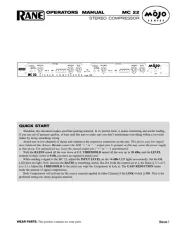
18 Juni 2025
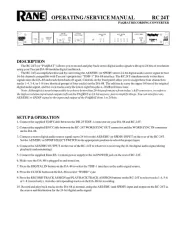
18 Juni 2025
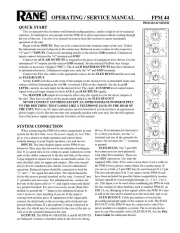
17 Juni 2025
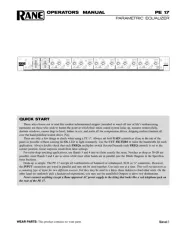
17 Juni 2025
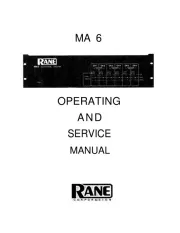
17 Juni 2025
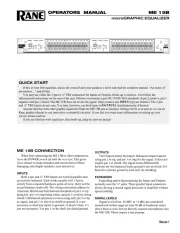
17 Juni 2025
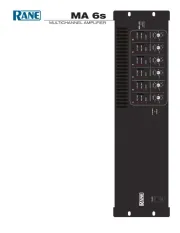
17 Juni 2025
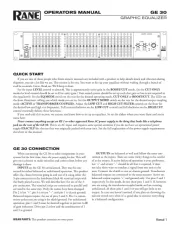
17 Juni 2025
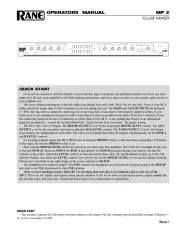
17 Juni 2025
Handleiding Mengpaneel
- Swissonic
- ATen
- Home Electric
- Yorkville
- Hanseatic
- Bestron
- Numark
- Fun Generation
- Alesis
- Domo
- Alfatron
- Ashly
- LD Systems
- Audibax
- Denon
Nieuwste handleidingen voor Mengpaneel

5 Augustus 2025
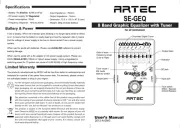
5 Augustus 2025
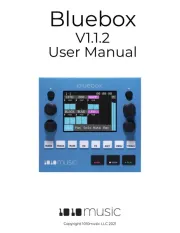
5 Augustus 2025
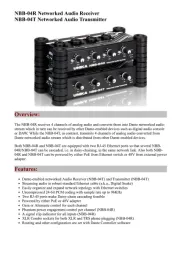
4 Augustus 2025

4 Augustus 2025
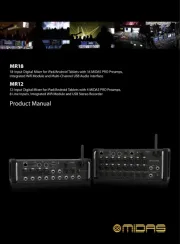
4 Augustus 2025

4 Augustus 2025

4 Augustus 2025
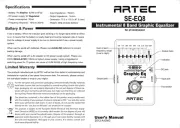
4 Augustus 2025
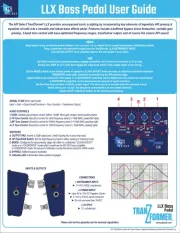
4 Augustus 2025